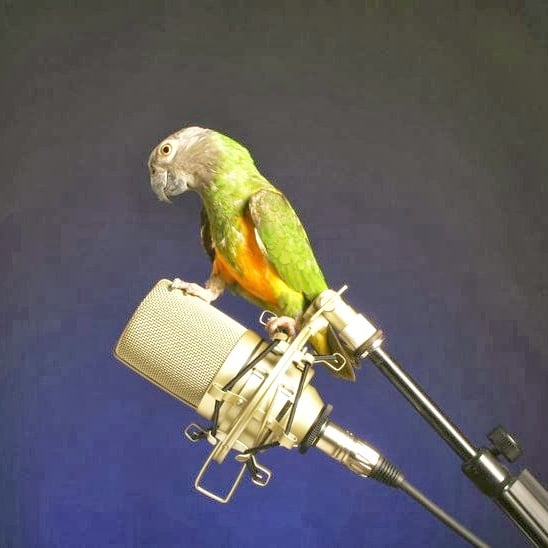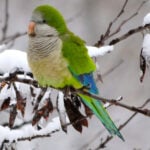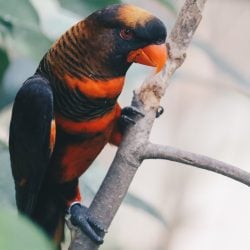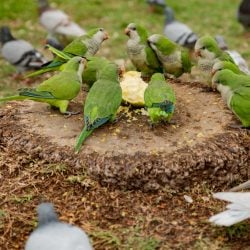
How Can Parrots Be Recognized by Their Voices?
Last Updated on by Mitch Rezman
Introduction
Have you ever noticed how you can tell who is talking, even if you can’t see them?
Maybe you know it’s your mom calling you from another room, or your friend shouting across the playground.
This is because every person has a unique voice, kind of like a fingerprint but for sound. Scientists call this a “voice-print.”
But did you know that some animals, like parrots, might have their own voice-prints too? This means that parrots could recognize each other just by the way they sound! A group of scientists wanted to find out if this was true for a type of parrot called the monk parakeet, which lives in Barcelona, Spain.
What Did the Scientists Want to Know?
The scientists already knew that parrots use special calls to keep in touch with each other. These are called “contact calls.” But they wanted to know more. They asked:
- Do parrots have a unique voice-print, like people do?
- Can this voice-print be found in other types of calls, not just contact calls?
- Is a parrot’s voice-print always the same, or does it change over time?
How Did They Study the Parrots?
The team watched and listened to 229 wild monk parakeets for two years.
Each bird had a special marker so the scientists could tell them apart. They recorded almost 5,600 sounds made by these birds! The sounds came from five different types of calls that parrots use for different reasons, like warning each other about danger, or calling to their friends.
Then, the scientists used computers to look really closely at these sounds. They measured things like how high or low the notes were, how long the calls lasted, and what patterns the sounds made. This helped them see if each parrot had its own special way of making calls.
What Did They Find?
The scientists discovered something amazing! In three out of the five types of calls, each parrot did have its own special “voice signature.” This means that, just like people, parrots can be recognized by their voices. It’s kind of like if every parrot had its own ringtone!
They also found that the contact calls—the ones parrots use to find their friends—were the most different from each other. This makes sense, because if you want your friend to find you in a noisy place, your call needs to stand out.
But, the scientists noticed something else. Even though parrots have their own special voices, their calls can change a little over time. It’s like how your voice might sound different if you have a cold, or as you get older.
Why Is This Important?
This discovery is really cool for a few reasons:
- Communication: It shows that parrots are really good at talking to each other. They can recognize who is calling, even if they can’t see the other bird. This helps them stay safe and find their friends.
- Learning: Parrots are smart and can learn new sounds. Knowing they have voice-prints means they might be able to learn even more, and maybe even copy each other’s voices.
- Conservation: If scientists can recognize parrots by their voices, they can study wild flocks without having to catch or disturb the birds. This is good for protecting parrots and learning more about their lives.
How Does This Compare to Humans?
Humans have voice-prints too. If you’ve ever used a voice assistant like Siri or Alexa, you know it can sometimes tell who is speaking. Our voices are shaped by things like the size of our mouth, nose, and throat, and how we use them. Parrots seem to have something similar, which lets them have their own “voice identity.”
What’s Next?
The scientists want to learn even more about how parrots use their voices. Do other types of parrots have voice-prints? Can parrots recognize the voices of their family members? And do baby parrots learn their voice from their parents, like humans do?
Fun Facts About Monk Parakeets
- Monk parakeets are small, green parrots with grey faces.
- They are very social and live in big groups.
- They build big nests out of sticks, sometimes with many rooms!
- Monk parakeets are not native to Spain—they were brought there from South America, but now they live in cities like Barcelona.
Conclusion
So, just like you can tell your friends apart by their voices, parrots can do the same thing! Each parrot has its own special way of calling that makes it unique. This helps them find their friends and family, stay safe, and live together in busy flocks.
The more we learn about how parrots talk, the more we see how smart and interesting they are. Maybe one day, we’ll be able to understand even more about what they’re saying to each other!
Sources
- Royal Society Publishing: Evidence for vocal signatures and voice-prints in a wild parrot
- ResearchGate summary: Evidence for vocal signatures and voice-prints in a wild parrot
- ResearchGate: Evidence for vocal signatures and voice-prints in a wild parrot (alternate summary)
LWritten by Mitch Rezman and the Windy City Parrot content team
Author Profile
Latest entries
 The Traveling BirdJune 26, 2025Can You Name 5 Parrot Species That Are Living Wild in the USA?
The Traveling BirdJune 26, 2025Can You Name 5 Parrot Species That Are Living Wild in the USA? Bird BehaviorJune 26, 2025How is it Parrots Are Problem Solvers Social Animals and Even Use Tools?
Bird BehaviorJune 26, 2025How is it Parrots Are Problem Solvers Social Animals and Even Use Tools? Bird & Parrot AnatomyJune 25, 2025How a Tiny Chemical Modification Makes Parrots Nature’s Living Paintings
Bird & Parrot AnatomyJune 25, 2025How a Tiny Chemical Modification Makes Parrots Nature’s Living Paintings PigeonsJune 20, 2025How Do Parrots Thrive in Cities Outside Their Native Habitats?
PigeonsJune 20, 2025How Do Parrots Thrive in Cities Outside Their Native Habitats?


